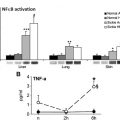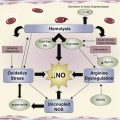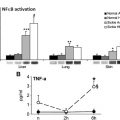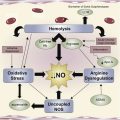Data suggest a role for adenosine signaling in the pathogenesis of sickle cell disease (SCD). Signaling through the adenosine A 2A receptor (A 2A R) has demonstrated beneficial effects. Activation of A 2A Rs decreases inflammation with SCD by blocking activation of invariant natural killer T cells. Decreased inflammation may reduce the severity of vasoocclusive crises. Adenosine signaling through the adenosine A 2B receptor (A 2B R) may be detrimental in SCD. Whether adenosine signaling predominantly occurs through A 2A Rs or A 2B Rs may depend on differing levels of adenosine and disease state (steady state versus crisis). There may be opportunities to develop novel therapeutic approaches targeting A 2A Rs and/or A 2B Rs for patients with SCD.
Key points
- •
Activation of adenosine A 2A receptor (A 2A R) on invariant natural killer T (iNKT) cells decreases inflammation in a transgenic mouse model of sickle cell disease (SCD). The effects of regadenoson, an A 2A R agonist, are currently being examined in patients with SCD.
- •
The adenosine A 2B receptor (A 2B R) on red blood cells and corpus cavernosal cells of the penis has been implicated in the formation of sickle erythrocytes and priapism, respectively.
- •
These 2 independent lines of research examining the roles of A 2A R and A 2B R signaling in SCD may provide opportunities for new therapies.
Introduction
SCD is characterized by rigid, sickle-shaped erythrocytes, microvascular occlusion, and tissue ischemia. Sickle erythrocytes initiate the development of vasoocclusion that ultimately leads to tissue ischemia in a complex multicellular process. Tissue ischemia promotes an inflammatory response that is further amplified by ischemia reperfusion injury. Thereafter, a vicious cycle of vasoocclusion, tissue injury, and inflammation is set into motion, promoting further erythrocyte sickling. The consequences of vasoocclusion are pain, end-organ damage, and often premature death.
Therapies for preventing or treating sickle cell vasoocclusion are limited. Broadly, treatments either prevent the formation of sickle erythrocytes (eg, hydroxyurea) or interrupt the cellular interactions that follow red cell sickling and lead to vasoocclusion. Hydroxyurea stimulates fetal hemoglobin synthesis in a variable fraction of erythroblasts and thereby inhibits polymerization of sickle hemoglobin and, to date, is the only Food and Drug Administration (FDA)-approved therapy for the prevention of painful vasoocclusive crises (pVOCs). Patient and provider barriers have limited the widespread use of hydroxyurea in patients with SCD, affecting the impact of the drug. Hematopoietic stem cell transplantation is a potential cure; however, it is an option for only a few patients with SCD.
This review examines the role of adenosine signaling in SCD pathogenesis. There are opportunities to modulate adenosine pathways using therapies to prevent or treat SCD complications. As evidence has emerged about the importance of adenosine in SCD, separate lines of investigation have demonstrated protective and detrimental effects of adenosine in regard to disease severity. Recent data suggest that actions of adenosine mediated through the A 2A R decrease inflammation, largely by selectively inhibiting the activation of a subset of lymphocytes, called iNKT cells. In contrast, other studies have shown that adenosine signaling through the A 2B R may contribute to the adverse processes of erythrocyte sickling and priapism. Although much additional work is needed to fully elucidate the roles of adenosine signaling in SCD, targeting these pathways may produce novel therapeutic approaches.
Introduction
SCD is characterized by rigid, sickle-shaped erythrocytes, microvascular occlusion, and tissue ischemia. Sickle erythrocytes initiate the development of vasoocclusion that ultimately leads to tissue ischemia in a complex multicellular process. Tissue ischemia promotes an inflammatory response that is further amplified by ischemia reperfusion injury. Thereafter, a vicious cycle of vasoocclusion, tissue injury, and inflammation is set into motion, promoting further erythrocyte sickling. The consequences of vasoocclusion are pain, end-organ damage, and often premature death.
Therapies for preventing or treating sickle cell vasoocclusion are limited. Broadly, treatments either prevent the formation of sickle erythrocytes (eg, hydroxyurea) or interrupt the cellular interactions that follow red cell sickling and lead to vasoocclusion. Hydroxyurea stimulates fetal hemoglobin synthesis in a variable fraction of erythroblasts and thereby inhibits polymerization of sickle hemoglobin and, to date, is the only Food and Drug Administration (FDA)-approved therapy for the prevention of painful vasoocclusive crises (pVOCs). Patient and provider barriers have limited the widespread use of hydroxyurea in patients with SCD, affecting the impact of the drug. Hematopoietic stem cell transplantation is a potential cure; however, it is an option for only a few patients with SCD.
This review examines the role of adenosine signaling in SCD pathogenesis. There are opportunities to modulate adenosine pathways using therapies to prevent or treat SCD complications. As evidence has emerged about the importance of adenosine in SCD, separate lines of investigation have demonstrated protective and detrimental effects of adenosine in regard to disease severity. Recent data suggest that actions of adenosine mediated through the A 2A R decrease inflammation, largely by selectively inhibiting the activation of a subset of lymphocytes, called iNKT cells. In contrast, other studies have shown that adenosine signaling through the A 2B R may contribute to the adverse processes of erythrocyte sickling and priapism. Although much additional work is needed to fully elucidate the roles of adenosine signaling in SCD, targeting these pathways may produce novel therapeutic approaches.
Adenosine signaling pathway
Adenosine Physiology
Adenosine signaling protects tissues by promoting vasodilation as well as by decreasing heart rate and inflammation. During periods of cellular hypoxia or stress, adenosine is released from cells along with the adenine nucleotides, ATP, ADP, and AMP, which are converted to adenosine by ectonucleotidases. Binding of adenosine to 4 receptor subtypes, A 1 , A 2A , A 2B , and A 3 , elicits responses that are dependent on the receptor subtypes found in various tissues ( Table 1 ). Adenosine receptors are 7-transmembrane, G-coupled receptors that signal through adenylyl cyclase, affecting the production of cyclic AMP (cAMP) and calcium or the conductance of ion channels. A 1 and A 3 receptors couple to inhibitory G receptors (Gi) and decrease adenylyl cyclase activity, whereas A 2A and A 2B increase adenylyl cyclase activity by coupling to stimulatory G receptors (Gs or Go). The affinity for adenosine also differs among the receptor subtypes, affecting the concentration of adenosine necessary for activation. A 1 and A 2A are high-affinity receptors, activating at lower concentrations of adenosine (approximately 0.01 μM–1 μM). A 2B is a low-affinity receptor requiring 10- to 1000-fold higher levels of adenosine (approximately 10 μM) for activation. Downstream from adenylyl cyclase and cAMP, adenosine signaling modifies the activity of nuclear factor κB (NF-κB), JAK-STAT, and ERK pathways, regulating transcription and ultimately cellular functions. Adenosine that accumulates during cellular stress is removed by uptake into cells and converted to AMP or inosine by adenosine kinase and adenosine deaminase (ADA), respectively. In patients with SCD, tissue injury may increase levels of plasma adenosine, suggesting that adenosine pathways may influence SCD pathogenesis.
| Characteristics | Adenosine Receptor Subtypes | |||
|---|---|---|---|---|
| A 1 | A 2A | A 2B | A 3 | |
| Predominant tissue/cell expression |
|
|
|
|
| Actions |
|
|
|
|
| Affinity for adenosine | High | High | Low | High |
| Major disease associations |
|
|
|
|
Current Therapeutic Uses of Adenosine and Adenosine Derivatives
Drugs that target adenosine receptors are part of current standard practice. Adenosine, dipyridamole, and adenosine A 2A R agonists (eg, regadenoson) are used clinically to induce cardiac hyperemia during myocardial stress testing via activation of coronary artery A 2A Rs. Adenosine-mediated activation of A 1 receptors in the heart is a treatment of tachyarrhythmias. Theophylline, either alone or in complex with ethylenediame (aminophylline), nonselectively blocks A 1 , A 2A , and A 2B receptors and is used as a therapy for asthma. A limitation of these therapies is lack of selectivity for the adenosine receptor subtypes, sometimes resulting in unwanted and potentially dangerous side effects. These include hypotension and tachycardia from A 2A R activation, bradycardia or heart block from A 1 activation and bronchospasm from A 2B R activation in patients with asthma. Newer-generation adenosine agonists and antagonists have greater receptor subtype selectivity, thereby minimizing toxicities. There are emerging cellular, animal, and human data suggesting a role for the A 2A and A 2B receptors in the pathogenesis of SCD ( Table 2 ). Adenosine-based therapies are currently being examined in patients with SCD ( Clinicaltrials.gov #01788631).
| Reference | Type of Study | Transgenic SCD Model | No. SCD Patients | Agents Evaluated | Key Findings |
|---|---|---|---|---|---|
| A 2A R | |||||
| VOC | |||||
| Wallace & Linden, 2010 | Investigation of transgenic SCD mice | NY1DD | — | A 2A R agonist ATL146e |
|
| Field et al, 2013 | Phase 1 clinical study | — | 27 | A 2A R agonist regadenoson |
|
| Lin et al, 2013 | Investigation of transgenic SCD mice | NY1DD | 8 | — |
|
| A 2B R | |||||
| Red blood cell sickling | |||||
| Zhang et al, 2011 | Investigation of transgenic SCD mice, cultured human red blood cells and SCD patient blood samples | Berkley | 12 | PEG-ADA, theophylline, A 2B R antagonist MRS1754 |
|
| Priapism | |||||
| Mi et al, 2008 | Investigation of ADA-deficient and transgenic SCD mice | Berkley | — | PEG-ADA, theophylline, A 2B R antagonist MRS1706 |
|
| Wen et al, 2010 | Investigation of ADA-deficient and transgenic SCD mice | Berkley | — | PEG-ADA |
|
| Wen et al, 2010 | Investigation of ADA-deficient and transgenic SCD mice | Berkley | — | PEG-ADA, A 2B R antagonist MRS1706 |
|
Role of A 2A R in sickle cell disease
A 2A R
A 2A R activation is well known for producing vasodilation due to effects on vascular smooth muscle and some endothelial cells. In addition, A 2A R has a central role in the regulation of inflammation and immunity. Ubiquitously expressed on neutrophils, monocytes, macrophages, T cells, natural killer cells, and iNKT cells, adenosine signaling through the A 2A R has been shown to suppress key inflammatory and immune responses, including leukocyte activation, recruitment, and cytokine production. These immune suppressive effects of A 2A R activation are mediated by cAMP and protein kinase A. Protein kinase A signaling can inhibit other signaling pathways that activate inflammation mediated by NF-κB or the JAK-STAT pathway and serves to decrease transcription of key inflammatory genes. The NF-κB pathway deserves special attention because it has been used as a marker of iNKT cell activity in clinical trials of the A 2A R agonist, regadenoson, in patients with SCD.
NF-κB is a critically important transcription factor that generally enhances inflammation. Comprised of a dimer of transcription factors from the RelA family of proteins (p50 or p52 and p65), NF-κB resides in the cytoplasm of cells bound to the inhibitory protein, IκB. On activation of the NF-κB by numerous inflammatory mediators, including tumor necrosis factor α or interleukin (IL)-1, IκB is phosphorylated by IκB kinase, ubiquinated, and degraded, thus liberating NF-κB to translocate into the nucleus and promote the transcription of proinflammatory genes. When NF-κB is released from IκB, the 65-kDa subunit (p65) can be phosphorylated on several sites, including Ser536. The phosphorylation of p65 (phospho-p65) serves as a marker of NF-κB activity used in flow cytometry assays. In cased of A 2A R activation, in vitro data suggest that agonists of the A 2A R reduce IκB degradation, decreasing the ability of NF-κB to promote a proinflammatory cellular response. NF-κB has also been shown to mediate the up-regulation of A 2A R in iNKT cells after activation.
A 2A R Agonist Decreases Inflammation After Ischemia-Reperfusion Injury by Interfering with iNKT-Cell Activation
Murine models of liver and kidney transplant demonstrated that activation of A 2A Rs by adenosine analogs administered during or after ischemia reperfusion injury markedly inhibit inflammation and secondary injury. An investigation of the cell type primarily responsible for the protective effect of A 2A R activation implicated the iNKT cell as the primary target. Although iNKT cells normally constitute less than 1% of the lymphocyte population, iNKT cells can rapidly release large amounts of proinflammatory cytokines, giving them a critical role in inflammation, despite representing only a small proportion of lymphocytes. Similar to B cells and T cells that produce adaptive immune responses, iNKT-cell activation requires the engagement of an antigen presented on an antigen-presenting cell. Unlike B cell and T cell populations, which express diverse receptors that recognize various peptides, iNKT cells express a semi-invariant T-cell receptor that nonspecifically binds to lipid antigens presented on CD1d, an major histocompatibility complex class I–like molecule. Different lipids (glycolipids and phospholipids) have been shown to activate iNKT cells. The activation of iNKT cells is enhanced by cytokines produced by antigen-presenting cells in response to Toll-like receptor activation. Thus, the activation of iNKT cells is facilitated by innate immune responses stimulated by pathogen-associated molecular patterns or danger-associated molecular patterns. On CD1d-restricted activation, iNKT cells rapidly make mRNAs and release large quantities of interferon-γ (IFN-γ), tumor necrosis factor α, IL-2, and IL-4. IFN-γ stimulates the production in many cells of interferon-inducible CXCR3 chemokines, CXCL9, CXCL10, and CXCL11. IL-2 is known to induce CXCR3 receptors on lymphocytes. Thus, through rapid activation and generation of copious amounts of cytokines and chemokines, iNKT cells stimulate a proinflammatory cascade that may promote and sustain vasoocclusion. Activation of A 2A Rs, abundantly expressed on activated iNKT cells, reduces this inflammatory response and is critical to modulating the immune functions of iNKT cells.
A 2A R Agonists Decrease iNKT-Cell Activation and Reduce Inflammation in SCD Mice
In a series of experiments in an NY1DD mouse model of SCD, Wallace and colleagues generated several lines of evidence implicating iNKT cells as critical to the process of sickle cell vasoocclusion. Lung inflammation and injury were reduced (1) when iNKT cells were antibody depleted or genetically knocked out, (2) when activation or chemotaxis was inhibited, and (3) on administration of A 2A R agonists. NY1DD mice treated with a continuous subcutaneous infusion of the A 2A R agonist ATL146e demonstrated a maximal improvement in lung function, histology, and inflammatory cell infiltrate in 3 days at an infusion rate of 10 ng/kg/min. The improvement was sustained up to the end of infusion at 7 days. The infused dose of ATL146e only achieved plasma concentrations of approximately 1 nM, and the mice did not demonstrate cardiovascular toxicities. The absence of toxicity is in accord with prior studies demonstrating that the antiinflammatory effects of A 2A R agonists occur at 10- to 100-fold lower concentrations compared with the cardiovascular effects. Blockade or depletion of iNKT cells mitigated the beneficial effects of the A 2A R agonist, providing evidence that the antiinflammatory actions of A 2A R activation are mediated largely through iNKT cells.
In the plasma of adult patients with SCD, circulating iNKT cells were also more likely to be activated and expanded compared with healthy controls. There is selective expansion of iNKT cells among lymphocytes, from less than 1% in control blood to an average of approximately 5% in the blood of SCD patients, whose iNKT cells were also more likely to express the activation markers, CD69, intracellular IFN-γ, and CXCR3.
Phase 1 Study of the A 2A R Agonist Regadenoson in Patients with SCD: Study Design and Rationale
Based on the promising data from mice and patients with SCD suggesting that A 2A R agonists may interrupt activation of iNKT cells and potentially decrease sickle cell complications, a phase 1 trial was conducted of the A 2A R agonist, regadenoson. FDA approved for inducing cardiac hyperemia during myocardial imaging, regadenoson is a selective A 2A R agonist with 10-fold greater affinity for A 2A versus A 1 and few, if any, effects on A 2B or A 3 . When used for myocardial imaging, regadenoson is administered as a 400-μg bolus over 10 seconds. Bolus injection induces vasodilation and hyperemia in a time frame appropriate for capturing images before blood flow reverts to normal. If the goal of administering regadenoson is to dampen the severity of a pVOC over several days, a continuous infusion is necessary, given its terminal half-life of 2 hours. When designing the study, 3 relatively low doses of regadenoson were selected based on data extrapolated from animal models. All of these doses produced the desired antiinflammatory effects while avoiding cardiovascular toxicities. Using a traditional 3 + 3 study design, the dose levels were examined during a 12-hour infusion of regadenoson while patients with SCD were at steady state. Once the highest dose of infusional regadenoson (1.44 μg/kg/h) was found safe, SCD subjects were examined during a 24- or 48-hour infusion at steady state and then during a pVOC.
To evaluate the effects of regadenoson on iNKT-cell activation, various activation markers were examined. Phospho-p65 NF-κB was identified as the most promising marker of iNKT-cell activation because, as opposed to cell surface markers or cytokines, changes in phosphorylation are pretranscriptional and thus occur quickly.
Phase 1 Study of the A 2A R Agonist Regadenoson in Patients with SCD: Study Results
Twenty-seven adult patients with SCD were administered regadenoson, 21 at steady state and 6 during pVOCs. Circulating iNKT cells from adults with SCD during pVOC showed increased phospho-p65 NF-κB activation compared with steady state or healthy controls. When adults with SCD were administered a 24-hour infusion of the A 2A R agonist regadenoson during pVOC, the percentage of iNKT cells expressing increased phospho-p65 NF-κB decreased to levels similar to steady state patients and healthy controls. The effects of regadenoson were achieved at plasma concentrations that peaked at 2 ng/mL and were devoid of effects on heart rate or blood pressure. Three children with SCD above the age of assent were also administered regadenoson without toxicity (unpublished data). A large, randomized, controlled, phase 2 trial is in progress to evaluate the clinical efficacy of regadenoson during pVOC ( Clinicaltrials.gov #01788631).
Stay updated, free articles. Join our Telegram channel

Full access? Get Clinical Tree







